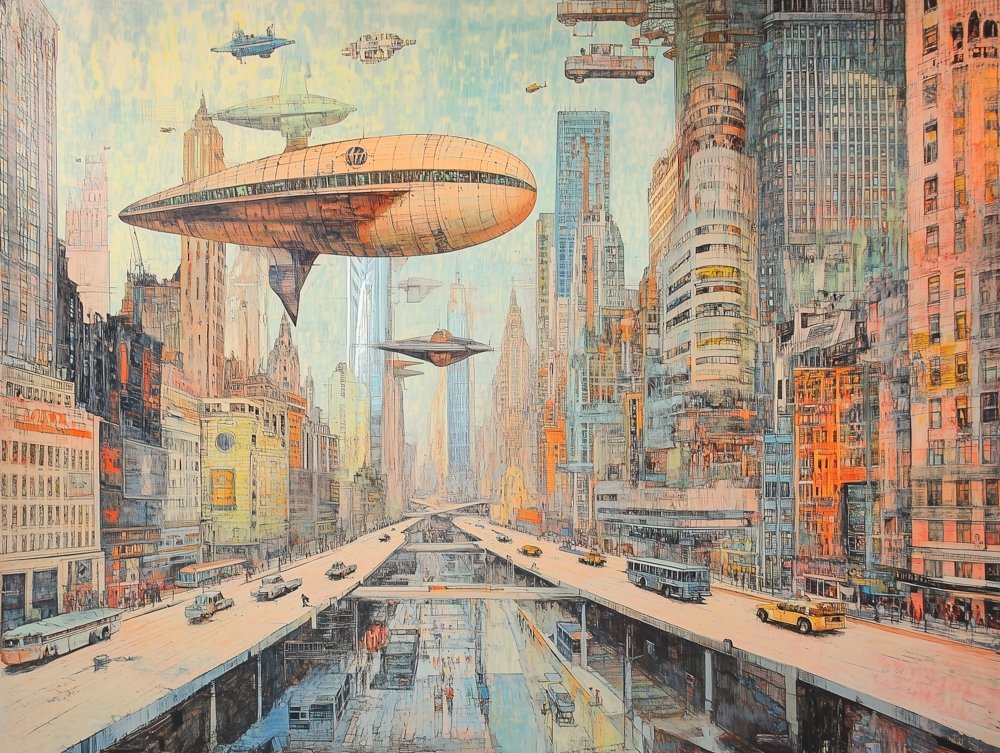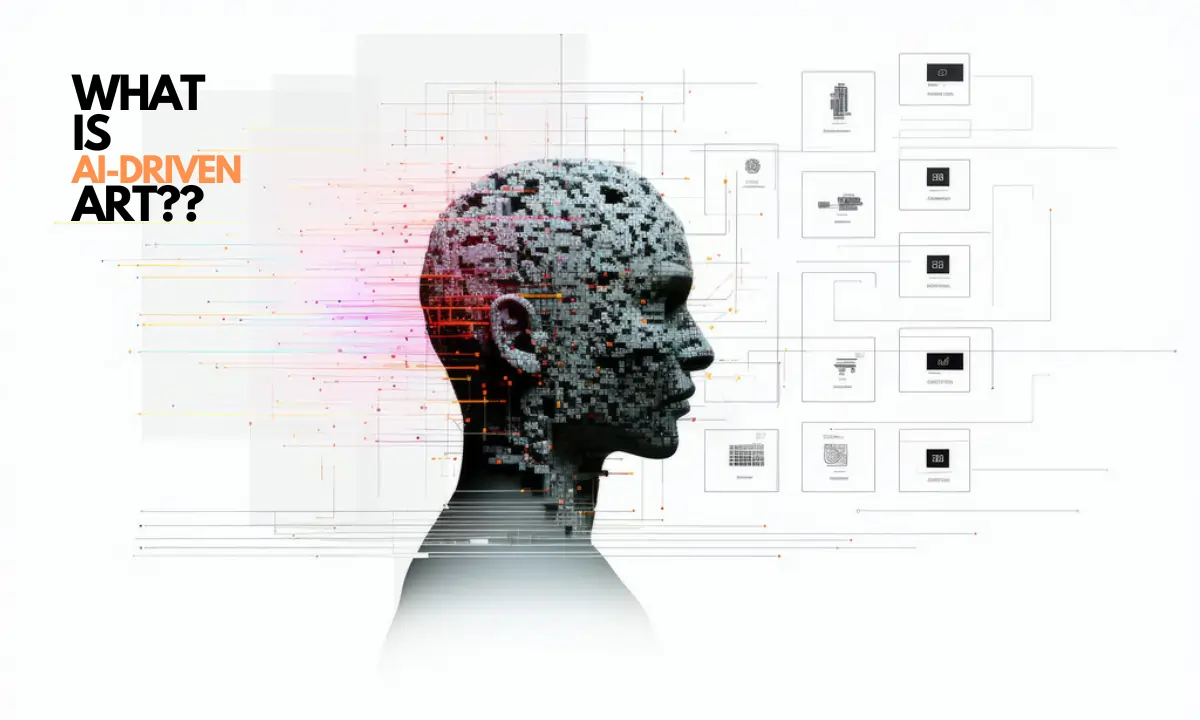In the Parisian gallery, the visitor stands mesmerized before the vast digital canvas. The vibrant colors twirl as well and morph into intricate designs, fading as well as re-emerging like fleeting dreams, and the creator is not the human artist but a model of AI trained to craft the visual masterpieces from the neural data. Moreover, this is the horizon of modern art where artificial intelligence, along with the creativity of humans, meet to reshape artistic expression.

Tracing the development of the AI in the creation of the artistic
The journey of AI as an artistic medium started with the early explorations in algorithmic design, and in the 1970s, Harold Cohen’s program AARON shaped abstract drawings with a series of instructions which are coded and marked the beginning of AI-assisted art. A few decades later, in the year 2015, the Deep Dream of Google captured global attention by generating surreal, dream-like visuals.
Nonetheless, it is uncanny the aesthetic introduced many to the creative of AI potential for the first time, and today’s advancements surpass the early experiments, with tools like DALL-E and MidJourney, which allows the generation of lifelike and imaginative art from the simple text prompts and these developments reflect the symbiotic relationship that the machines serve as an extension of the creativity of the human, pushing the boundaries rather than replacing the inventiveness.
The technology powering the art of AI-driven
The AI art lies in the revolutionary innovations of technology, and machine learning, particularly generative adversarial networks (GANs), has transformed the field and allowed for the creation of hyper-realistic imagery and transformer models like the Stable Diffusion bridge the textual descriptions along with the visual representation which enabling the highly nuanced outputs. On top of that, the emerging platforms are pushing these innovations further. The systems of the Text-to-video turn the written prompts into the animated artworks and it transitions the static visuals into the dynamic narratives.
Meanwhile, the augmented virtual reality (AR/VR) installations immerse the audiences in interactive artistic experiences where the blurs of AI are the line between viewer and creator as well. These advancements illustrate how AI transcends imitation and redefines how art is considered and consumed.
The partnerships of Humans and AI
Contrary to the fears that AI might outshine the artistry of humans, it often improves creative expression. Sougwen Chung’s Drawing Operations series exemplifies this harmony, pairing the robotic arms with her hand-drawn gestures to produce cooperative works. This interplay between intuition as well as precision underlines the role of AI as an enabler of human potential, and the democratization of the art is another transformative aspect of the rise of AI.
On this point, the platforms empower the laypersons to produce polished works, while the professionals leverage the AI to explore hybrid aesthetics, merging diverse styles as well as pushing the conceptual limits. A striking example is Refik Anadol’s Melting Memories, where the brainwave data is transformed into visual installations, deepening our sympathy for memory and perception.
Ethical and Philosophical Reflections
The arrival of AI-driven art raises profound ethical along with philosophical questions who holds the authorship over the works of AI-generated? In the year 2018, Christie’s auctioned Edmond de Belamy, an AI-crafted portrait, for $432,500, and the artwork was marketed as the brainchild of artificial intelligence, yet its human creators who developed the algorithm were largely overlooked. Nevertheless, this debate on intellectual property remains unresolved. Bias is another significant concern, and the models of the AI trained on biased datasets risk perpetuating the stereotypes of the culture, favouring the familiar Western styles over broader global traditions. Lastly, the critics argue that unless these biases are addressed, the AI art could reinforce the existing inequalities rather than foster diversity.
Philosophically, the spirit of the creativity itself is questioned and does the AI truly create or does it merely recombine the pre-existing elements? As the artist Alex Reben suggests, AI can astonish us, but it operates within the boundaries of the data we provide, and this paradox is concurrently innovative yet derivative, the issues of long-held notions of originality in art.
Pioneers shaping the art of AI
The transformative effect of AI in art is best understood by its trailblazers, and Refik Anadol’s immersive installations, like the Infinity Room, use projections along with mirrors to create infinite, ever-evolving environments and also offer thoughtful spaces that merge the data with emotion. Similarly, the digital artist Beeple confirmed the commercial potential of the art of AI with his NFT Every Day and the First 5000 Days, which sold for an astonishing $69 million. This milestone merged the creativity of AI with the technology of the blockchain and it transformed the digital art market.
| Artist/Project | Contribution | Impact |
| Refik Anadol | Data-driven immersive installations | Redefining sensory and emotional art |
| Beeple | NFTs and blockchain integration | Transforming art ownership and commerce |
| Sougwen Chung | Human-AI collaborative creations | Exploring intuition and machine synergy |
The future of AI art
The impact of AI on art will only deepen like the text-to-video tools as well as AI-powered sculptures hint at new possibilities, while the advances in emotion-sensing technologies could enable the artworks that respond to the moods of the viewers in real-time and the integration of the blockchain will secure the digital ownership, nurturing the trust and innovation in the art ecosystem. Sustainability, however, will be crucial, and the energy-efficient algorithms must offset the environmental footprint of the AI; while inclusive and ethically curated, the datasets will ensure fairness along with diversity in the creation of the AI art.
Conclusion
In the end, AI-driven art demonstrates humanity’s endless pursuit of innovation as well as interlacing machine intelligence with the ingenuity of humans, and it redefines artistic expression while prompting vital ethical as well as philosophical debates. Lastly, this fusion is not about replacing the creativity of humans but enriching it and also opening the universe of possibilities that celebrate the endless dance of art along with technology.
FAQ
What is AI-driven art?
AI-driven art involves machines generating visuals by analyzing and interpreting neural or textual data.
How did AI in art evolve?
It started with algorithmic design, advancing through GANs and transformer models like DALL-E.
What technology powers AI art?
Generative adversarial networks and transformer models enable nuanced, lifelike visual and textual creations.
How do humans and AI collaborate in art?
Artists use AI tools to enhance creativity, producing innovative, hybrid aesthetics and styles.
What ethical concerns exist in AI art?
Authorship, data bias, and originality challenges provoke debates on fairness, ownership, and cultural diversity.
What’s the future of AI-driven art?
AI art may include emotion-responsive creations, AI sculptures, blockchain integration, and sustainable technologies.


